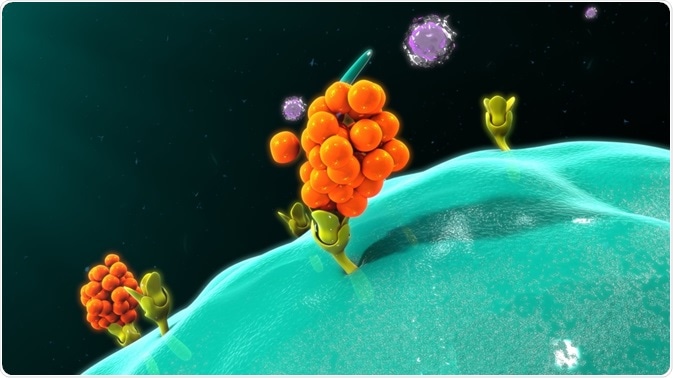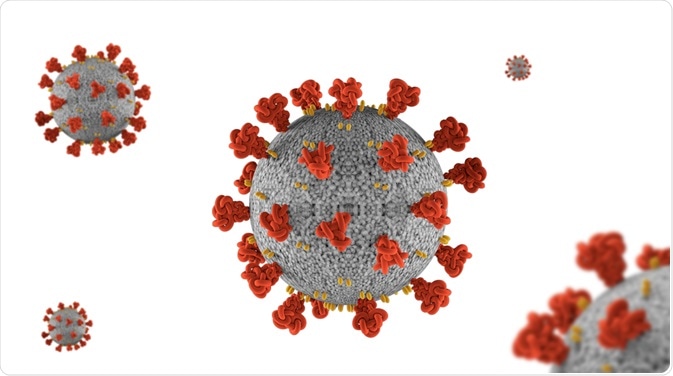Human disease etiology is complex, many diseases are a result of defects in cellular pathways especially with animal cell signaling being notoriously fickle.

Image Credit: sciencepics/Shutterstock.com
A well-known and studied family of secreted signaling molecules are known as the cytokine family which have a general role in mediating the immune response. Chemokines (chemotactic cytokines) are a subgroup of cytokines known for their influence on cell migration. Defects in cytokine signaling are observed in a vast variety of diseases including cancers, autoimmune disorders, and - recently - COVID-19.
Cytokines
Cytokines are secreted signaling molecules that can be subdivided and classified by their actions. They are involved in or affect nearly every biological process in the human body but are thoroughly investigated in oncology and immunology. Cytokines can be divided by their effect on the immune response such as pro-inflammatory or anti-inflammatory or due to their biological properties.
Some common examples of cytokines are interleukins (IL), tumor necrosis factors (TNF), and interferons (IFN). Chemokines are more succinctly divided into four subgroups according to the location of cysteine residues within the primary structure: CC, CXC, CX3C, and XC. Chemokines are most studied for their role in leukocyte cell migration.
Often cytokine signaling pathways overlap and interact, therefore any errors can range from inconvenient to fatal. Considering cancer, cytokines and chemokines have a strongly established link with tumor growth and progression.
Tumor cells are capable of regulating their own microenvironment and can facilitate disease progression via cell recruitment, angiogenesis, and metastasis. Immune cell infiltration is a common factor of tumor development, chemokine release can promote leukocyte invasion, for example, natural killer cells or regulatory T-cells.
Natural killer cells indicate a good prognosis, their recruitment is mediated by chemokines, specifically CXCR3, whereas the presence of regulatory T-cells can indicate a bad prognosis due to their capability of potent immunosuppression.
Furthermore, evidence exists that metastasis is promoted via T-helper type 2 cytokines (IL-3,4,5, and 13), histopathological studies in renal cell carcinoma have found that the T-helper type 2 profile indicate a more “active” disease which indicates an aggressive phenotype with higher metastatic potential, whereas a T-helper type 1 profile (IL-2, IL-12, TNF-α, IFN-γ) is associated with a disease-free phenotype. Additionally, shifts from type 1 to type 2 profiles are seen with successful therapy.
As well as tumorigenesis, neurological disorders have connections with cytokine function. In a healthy individual, cytokine signaling assists in neuroprotection via glial cells. Usually, upon injury or infection, microglia act by regulating adaptive and innate immune responses as well as phagocytosis of pathogenic debris.
IL-6 is a cytokine released by astrocytes in response to damage to neurons to promote neuron survival but has been implicated in exacerbating endothelial cell degeneration in the blood-brain barrier which a study in 2018 suggests could be an early prognostic factor for amyotrophic lateral sclerosis. Similarly, high concentrations of proinflammatory cytokines with a decrease in anti-inflammatory cytokines correlate with larger infarcts and worse prognosis in animal models of stroke.
Additionally, there may be overlaps in disease as a result of dysregulated cytokine signaling. In a cohort of children with a family history of autoimmune disorders that correlate with increased levels of proinflammatory cytokines such as type-1 diabetes, rheumatoid arthritis, or celiac disease, it was found that there is a higher occurrence of infantile autism. IL-6 is associated with the latter described autoimmune disorders. With regards to chemokines, there is evidence of their involvement in diabetic neuropathy.
Chemokines
Chemokine CXCR4 receptor signaling mediates pain, studies using AMD3100 as a specific CXCR4 antagonist showed some reversal of the effects of neuropathy in animal models. Furthermore, to strengthen the association between autoimmune disorders and neurological disorders, a fascinating link between gluten intake among adults, with or without celiac disease, and the severity of ataxia in some adults.
Most recently, prognosis in COVID-19 has been linked to proinflammatory cytokine levels, including that of IL-6. In addition to excessive levels of chemokines, CXCL10 and CCL2 were observed in bronchoalveolar lavage fluid cells. The overproduction of pro-inflammatory factors due to a loss of a negative feedback response is referred to as a cytokine storm, an acute response characterized by its rapid progression and uncontrolled positive feedback loop.
This attack largely involves inflammatory cytokines and the entire chemokine family and can lead to multiple organ failure in some but almost certainly results in acute lung damage due to its pulmonary origin. Steroids are usually administered to combat this response, but issues mostly occur in predicting and identifying the occurrence of cytokine storms.

Image Credit: GEMINI PRO STUDIO/Shutterstock.com
Conclusion
Cytokines and chemokines are thoroughly involved in the immune response, however, the vast overlap and complexity of signaling behaviors can result in disastrous effects with a range of severity when dysfunctional. It is undeniable that cytokine signaling is a key factor to innate and adaptive immunity, but research within these pathways lags due to its immense scale and complexity.
Despite this, research progresses with the notion that eventually, understanding will enable the reversal or slowing of destructive chronic diseases.
Further Reading
Last Updated: Nov 20, 2020